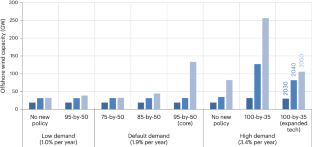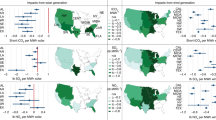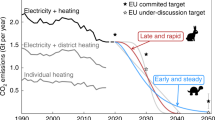Abstract
An assessment of decarbonization pathways in energy models reveals fundamental limitations in representing factors that are relevant for practical decision-making. Although these modelling limitations are widely acknowledged, their impact on the deployment of individual power generation types is not well understood. As a result, the societal value from such generation types could be vastly misrepresented. Here we explore a wide spectrum of factors that impact offshore wind deployment in the United States using a detailed capacity expansion model. Many factors prescribe a large future role for offshore wind, yet this diverges from what models often show. We extend the typically narrow modelling context through high spatial resolution, several cost and transmission possibilities and various energy-sector policies. We estimate offshore wind to constitute 1–8% (31–256 gigawatts) of total US generation by 2050. This wide range suggests an uncertain but potentially important regional role. Our expansive scenarios demonstrate how to address many limitations of decarbonization modelling.
This is a preview of subscription content, access via your institution
Access options
Access Nature and 54 other Nature Portfolio journals
Get Nature+, our best-value online-access subscription
$29.99 / 30 days
cancel any time
Subscribe to this journal
Receive 12 digital issues and online access to articles
$119.00 per year
only $9.92 per issue
Buy this article
- Purchase on Springer Link
- Instant access to full article PDF
Prices may be subject to local taxes which are calculated during checkout





Similar content being viewed by others
Data availability
The ReEDS model datasets analysed in this article are described in ‘Data’ in the Methods. Source data are provided with this paper.
Code availability
The source code for the ReEDS model is available at https://github.com/NREL/ReEDS-2.0. Further information related to the ReEDS code, data and assumptions is available from M.M. (Matthew.Mowers@nrel.gov).
References
Moallemi, E. A. & Malekpour, S. A participatory exploratory modelling approach for long-term planning in energy transitions. Energy Res. Soc. Sci. 35, 205–216 (2018).
Helistö, N., Kiviluoma, J., Holttinen, H., Lara, J. D. & Hodge, B.-M. Including operational aspects in the planning of power systems with large amounts of variable generation: a review of modeling approaches. WIREs Energy Environ. 8, e341 (2019).
Pfenninger, S., Hawkes, A. & Keirstead, J. Energy systems modeling for twenty-first century energy challenges. Renew. Sustain. Energy Rev. 33, 74–86 (2014).
Ellenbeck, S. & Lilliestam, J. How modelers construct energy costs: discursive elements in energy system and integrated assessment models. Energy Res. Soc. Sci. 47, 69–77 (2019).
Li, J., Zhang, J., Ge, W. & Liu, X. Multi-scale methodology for complex systems. Chem. Eng. Sci. 59, 1687–1700 (2004).
Sterman, J. All models are wrong: reflections on becoming a systems scientist. Syst. Dyn. Rev. 18, 501–531 (2002).
DeCarolis, J. et al. Formalizing best practice for energy system optimization modelling. Appl. Energy 194, 184–198 (2017).
Keepin, B. & Wynne, B. Technical analysis of IIASA energy scenarios. Nature 312, 691–695 (1984).
Gils, H. C. et al. Modeling flexibility in energy systems—comparison of power sector models based on simplified test cases. Renew. Sustain. Energy Rev. 158, 111995 (2022).
Bistline, J., Diamant, A. & Hytowitz, R. Incorporating Energy Storage Resources into Long-Term Capacity Planning Models Technical Report 3002021969 (Electric Power Research Institute, 2021); https://www.epri.com/research/products/000000003002021969
McCollum, D. L., Gambhir, A., Rogelj, J. & Wilson, C. Energy modellers should explore extremes more systematically in scenarios. Nat. Energy 5, 104–107 (2020).
Pye, S. et al. Modelling net-zero emissions energy systems requires a change in approach. Clim. Policy https://doi.org/10.1080/14693062.2020.1824891 (2021).
Pedersen, T. T., Victoria, M., Rasmussen, M. G. & Andresen, G. B. Modeling all alternative solutions for highly renewable energy systems. Energy 234, 121294 (2021).
Musial, W. et al. Offshore Wind Market Report: 2021 Edition Technical Report DOE/GO-102021-5614 (US Department of Energy, Office of Energy Efficiency and Renewable Energy, 2021); https://www.energy.gov/sites/default/files/2021-08/Offshore%20Wind%20Market%20Report%202021%20Edition_Final.pdf
Beiter, P. et al. Expert perspectives on the wind plant of the future. Wind Energy 25, 1363–1378 (2022).
Mills, A. et al. Estimating the value of offshore wind along the United States’ eastern coast. Environ. Res. Lett. 13, 094013 (2018).
Wang, Y.-H. et al. Spatial and temporal variation of offshore wind power and its value along the Central California Coast. Environ. Res. Commun. 1, 121001 (2019).
Douville, T., Bhatnagar, D., O’Neil, R. & Mongird, K. Exploring the Grid Value Potential of Offshore Wind Energy in Oregon OCS Study BOEM 2020-026, PNNL-29935 (Pacific Northwest National Laboratory, 2020); https://www.pnnl.gov/main/publications/external/technical_reports/PNNL-29935.pdf
Beiter, P. et al. A Spatial-Economic Cost-Reduction Pathway Analysis for U.S. Offshore Wind Energy Development from 2015–2030 Technical Report NREL/TP-6A20-66579 (National Renewable Energy Laboratory, 2016); https://www.nrel.gov/docs/fy16osti/66579.pdf
Bistline, J. et al. Electric sector policy, technological change, and U.S. emissions reductions goals: results from the EMF 32 model intercomparison project. Energy Econ. 73, 307–325 (2018).
Mai, T. et al. The role of input assumptions and model structures in projections of variable renewable energy: a multi-model perspective of the U.S. electricity system. Energy Econ. 76, 313–324 (2018).
Luderer, G. et al. Impact of declining renewable energy costs on electrification in low-emission scenarios. Nat. Energy 7, 32–42 (2022).
Kanyako, F. & Baker, E. Uncertainty analysis of the future cost of wind energy on climate change mitigation. Clim. Change 166, 10 (2021).
Cranmer, A. & Baker, E. The global climate value of offshore wind energy. Environ. Res. Lett. 15, 054003 (2020).
Victoria, M., Zhu, K., Brown, T., Andresen, G. B. & Greiner, M. Early decarbonisation of the European energy system pays off. Nat. Commun. 11, 6223 (2020).
Soares-Ramos, E. P. P., de Oliveira-Assis, L., Sarrias-Mena, R. & Fernández-Ramírez, L. M. Current status and future trends of offshore wind power in Europe. Energy 202, 117787 (2020).
Schlachtberger, D. P., Brown, T., Schäfer, M., Schramm, S. & Greiner, M. Cost optimal scenarios of a future highly renewable European electricity system: exploring the influence of weather data, cost parameters and policy constraints. Energy 163, 100–114 (2018).
Schlachtberger, D. P., Brown, T., Schramm, S. & Greiner, M. The benefits of cooperation in a highly renewable European electricity network. Energy 134, 469–481 (2017).
Gils, H. C., Scholz, Y., Pregger, T., Luca de Tena, D. & Heide, D. Integrated modelling of variable renewable energy-based power supply in Europe. Energy 123, 173–188 (2017).
Bistline, J. E. T. Roadmaps to net-zero emissions systems: emerging insights and modeling challenges. Joule 5, 2551–2563 (2021).
Mai, T. et al. Electrification Futures Study: Scenarios of Electric Technology Adoption and Power Consumption for the United States Technical Report NREL/TP-6A20-71500 (National Renewable Energy Laboratory, 2018); https://www.nrel.gov/docs/fy18osti/71500.pdf
Jorgenson, J., Awara, S., Stephen, G. & Mai, T. Comparing Capacity Credit Calculations for Wind: A Case Study in Texas Technical Report NREL/TP-5C00-80486 (National Renewable Energy Laboratory, 2021); https://www.nrel.gov/docs/fy21osti/80486.pdf
Barter, G. E., Robertson, A. & Musial, W. A systems engineering vision for floating offshore wind cost optimization. Renew. Energy Focus 34, 1–16 (2020).
Musial, W. & Butterfield, S. Future for Offshore Wind Energy in the United States Technical Report NREL/CP-500-36313 (National Renewable Energy Laboratory, 2004); https://www.nrel.gov/docs/fy04osti/36313.pdf
Mai, T., Mowers, M., Beiter, P., Lopez, A. & Brown, P. The Determinants of Offshore Wind’s Role in a Future U.S. Energy System: A Preliminary Modeling Sensitivity Analysis [Slides] Presentation NREL/PR-6A40-82101 (Office of Scientific and Technical Information, 2022); https://www.osti.gov/biblio/1869691
Lopez, A. et al. Land use and turbine technology influences on wind potential in the United States. Energy 223, 120044 (2021).
Cole, W. et al. 2021 Standard Scenarios Report: A U.S. Electricity Sector Outlook Technical Report NREL/TP-6A40-80641 (National Renewable Energy Laboratory, 2021); https://www.nrel.gov/docs/fy22osti/80641.pdf
Lopez, A. et al. Offshore Wind Energy Technical Potential for the Contiguous United States (National Renewable Energy Laboratory, 2022); https://www.nrel.gov/docs/fy22osti/83650.pdf
Flint, S., deMesa, R., Doughman, P. & Huber, E. Offshore Wind Energy Development off the California Coast Technical Report CEC-800-2022-001-REV (California Energy Commission, 2022); https://www.energy.ca.gov/filebrowser/download/4361
Shields, M. et al. A Supply Chain Road Map for Offshore Wind Energy in the United States Technical Report NREL/TP-5000-84710 (National Renewable Energy Laboratory, 2023); https://www.nrel.gov/docs/fy23osti/84710.pdf
Neumann, F. & Brown, T. The near-optimal feasible space of a renewable power system model. Electr. Power Syst. Res. 190, 106690 (2021).
Komiyama, R. & Fujii, Y. Large-scale integration of offshore wind into the Japanese power grid. Sustain. Sci. 16, 429–448 (2021).
Gao, A., Huang, C., Lin, J. & Su, W. Review of recent offshore wind power strategy in Taiwan: onshore wind power comparison. Energy Strategy Rev. 38, 100747 (2021).
Mai, T., Lopez, A., Mowers, M. & Lantz, E. Interactions of wind energy project siting, wind resource potential, and the evolution of the US power system. Energy 223, 119998 (2021).
Buchholz, S., Gamst, M. & Pisinger, D. Finding a portfolio of near-optimal aggregated solutions to capacity expansion energy system models. SN Oper. Res. Forum 1, 7 (2020).
Ho, J. et al. Regional Energy Deployment System (ReEDS) Model Documentation: Version 2020 Technical Report NREL/TP-6A20-78195 (National Renewable Energy Laboratory, 2021); https://www.nrel.gov/docs/fy21osti/78195.pdf
Gates, N., Cole, W., Frazier, W. & Gagnon, P. Evaluating the Interactions Between Variable Renewable Energy and Diurnal Storage Technical Report NREL/TP-6A20-78042 (National Renewable Energy Laboratory, 2021); https://www.nrel.gov/docs/fy22osti/78042.pdf
Annual Technology Baseline. National Renewable Energy Laboratory https://atb.nrel.gov (2021).
Denholm, P. et al. Examining Supply-Side Options to Achieve 100% Clean Electricity by 2035 Technical Report NREL/TP-6A40-81644 (National Renewable Energy Laboratory, 2022); https://www.nrel.gov/docs/fy22osti/81644.pdf
Annual Energy Outlook 2021 (US Energy Information Administration, 2021); https://www.eia.gov/outlooks/aeo/pdf/AEO_Narrative_2021.pdf
Murphy, C. et al. Electrification Futures Study: Scenarios of Power System Evolution and Infrastructure Development for the United States Technical Report NREL/TP-6A20-72330 (National Renewable Energy Laboratory, 2021); https://www.nrel.gov/docs/fy21osti/72330.pdf
Maclaurin, G. et al. The Renewable Energy Potential (reV) Model: A Geospatial Platform for Technical Potential and Supply Curve Modeling Technical Report NREL/TP-6A20-73067 (National Renewable Energy Laboratory, 2019); https://www.nrel.gov/docs/fy19osti/73067.pdf
Barbose, G. U.S. Renewables Portfolio Standards. 2021 Status Update: Early Release (Lawrence Berkeley National Laboratory, 2021); https://eta-publications.lbl.gov/sites/default/files/rps_status_update-2021_early_release.pdf
Acknowledgements
This work was authored in part by the National Renewable Energy Laboratory, operated by Alliance for Sustainable Energy, LLC, for the US Department of Energy (DOE) under Contract No. DE-AC36-08GO28308. Funding is provided by the US DOE Office of Energy Efficiency and Renewable Energy Wind Energy Technologies Office. The views expressed in the article do not necessarily represent the views of the DOE or the US Government. The US Government retains, and the publisher, by accepting the article for publication, acknowledges that the US Government retains a nonexclusive, paid-up, irrevocable, worldwide license to publish or reproduce the published form of this work, or allow others to do so, for US Government purposes. The views expressed are purely those of the authors only.
Author information
Authors and Affiliations
Contributions
P.B., T.M. and J.B. conceived and conceptualized the study. M.M., T.M. and P.B. performed the analysis. P.B., T.M. and J.B. wrote the manuscript. M.M. edited the manuscript and provided guidance on the analysis and technical assumptions.
Corresponding author
Ethics declarations
Competing interests
The authors declare no competing interests.
Peer review
Peer review information
Nature Energy thanks Jose Lara, Hans Christian Gils and the other, anonymous, reviewer(s) for their contribution to the peer review of this work.
Additional information
Publisher’s note Springer Nature remains neutral with regard to jurisdictional claims in published maps and institutional affiliations.
Supplementary information
Supplementary Information
Supplementary Tables 1–4, Figs. 1–12 and Note 1.
Supplementary Data 1
Source data for Supplementary Figs. 1–6 and 8–12.
Source data
Source Data Fig. 1
Source data for Fig. 1 (policy and demand scenarios).
Source Data Fig. 2
Source data for Fig. 2 (generation and capacity in the core scenario).
Source Data Fig. 3
Source data for Fig. 3 (offshore wind generation fraction in 2050).
Source Data Fig. 4
Source data for Fig. 4 (offshore wind capacity in 2050).
Source Data Fig. 5
Source data for Fig. 5 (wind deployment by site in 2050).
Rights and permissions
Springer Nature or its licensor (e.g. a society or other partner) holds exclusive rights to this article under a publishing agreement with the author(s) or other rightsholder(s); author self-archiving of the accepted manuscript version of this article is solely governed by the terms of such publishing agreement and applicable law.
About this article
Cite this article
Beiter, P., Mai, T., Mowers, M. et al. Expanded modelling scenarios to understand the role of offshore wind in decarbonizing the United States. Nat Energy 8, 1240–1249 (2023). https://doi.org/10.1038/s41560-023-01364-y
Received:
Accepted:
Published:
Issue Date:
DOI: https://doi.org/10.1038/s41560-023-01364-y



